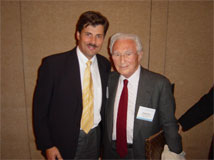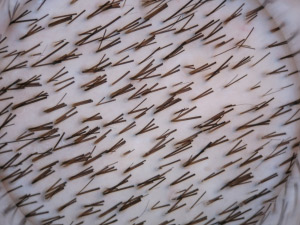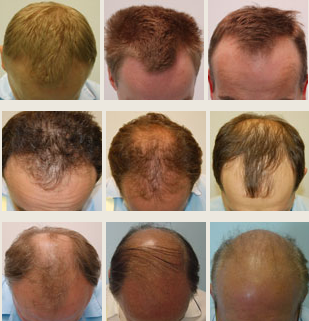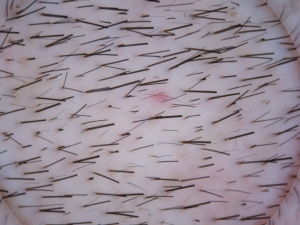About the surgery
Hair transplant procedure is a surgical intervention that involves restoring hair in bald and thinning regions. It is performed due to the following reasons:
- Male androgenic alopecia
- Female androgenic alopecia
- Posttraumatic baldness
- Post-burn alopecia
- Hairloss from radiation
- Postinflammatory alopecia – after the inflammatory state is healed
- Post-operative scarring
- A supplement of hair restoration surgeries of the scalp
- Hairloss in the regions of eyebrows, lashes, moustache and the chin
- Hairloss in pubic regions
- Hair restoration on the chest in the case of transvestites
 Hair transplant procedure was first described in 1959 by the American doctor Norman Orentreich who is generally recognized worldwide as a pioneer in this field of surgical procedures.
Hair transplant procedure was first described in 1959 by the American doctor Norman Orentreich who is generally recognized worldwide as a pioneer in this field of surgical procedures.
Hair grafts used by Orentreich had the diameter of 4-5 mm and, in comparison to today’s surgeries, they did not produce a very aesthetic effect.
In 1981 Rolf Nordsrtom as the first in the world described the application of micrografts. They improved considerably the aesthetic effects of the treatment.
 In 1984 Headington as the first explained the notion of follicular units. In the 90s of 20c. the surgeris using follicular units gained bigger and bigger popularity and today they have become one of the leading methods of hair transplantation surgeries.
In 1984 Headington as the first explained the notion of follicular units. In the 90s of 20c. the surgeris using follicular units gained bigger and bigger popularity and today they have become one of the leading methods of hair transplantation surgeries.
In 1984 it was Jerzy Kolasinski, M.D., who performed the surgery of hair transplantation as the first in Poland.
In hair transplantation surgeries a scalp fragment is extracted from the back regions of the head, next it is cut up into small grafts containing single follicular units (FU), and afterwards FUs are implanted into bald regions.

A microscopic picture of natural hair growth as a group of follicular units.
The FUE (follicular units extraction) method has been quite popular for the last few years.
In contrast to the classical methods, in the first stage, single folliular units are collected from the back region of head. The consecutive phases of the surgery are similar.
Is hair transplantation right for you?
Hair transplantation surgery can improve both your appearance and your mood which does not mean that you will look perfectly and that the attitude of other people towards you will change.
Before you take the final decision, think over carefully your expectations and discuss them with our surgeon.
Best candidates for hair transplantation surgery are people of reasonable expectations, in the case of whom the process of baldness is noticable in a particular part of the head. In other words, it is possible to determine exactly the regions of hairloss, or those which are thinned out (the recipient region) as well as regions of stable, good hair growth (the donor region).
The surgery should not be performed in the case of more advanced patterns of hairloss.
Also people with vague and too high expectations should not undergo the surgery of hair transplantation because the obtained effect may be for them not only very unsatisfactory but may also become a source of psychological discomfort.
Advanced diabetes, serious cardiovascular diseases , irregular hypertension, inflammable diseases of the scalp, ‘patchy’ hairloss, all pose contraindications to perform hair transplantation surgery.
However, if you are a healthy person and your expectations are reasonable, you can be a right person to undergo the surgery.
Male hairloss
Androgenic balding is the most frequent type of balding in case of men. Its reason remains unknown, although some genetic prerequisites may play a huge role in here. The second extremely import ant factor triggering this process is an active form of a male testosterone hormone called dihydrotestosterone (DHT).
This type of baldness most often is so typical that it is called ‘male pattern baldness’. Each stage of the process was described precisely by Norwood. It allows to define easily a current state of the scalp. It also facilitates the specification of the range of the corrective treatment.

The process of baldness most often begins at the age of 18-20. However, it also happens that the first signs of hairloss take place at the age of 40 or even 50. Generally speaking, the later the process of balding starts, the better prospects of its treatment are.
The colour, thickness and the structure of hair is taken into account in the case of a patient suffering from alopecia. A significant prognostic factor here is a family interview. A man whose father, grandfather and brothers all suffer from baldness has smaller chances of hair preservation.
The treatment of androgenic alopecia in the case of young man starts with the application of Propecia (finasteroid). It is a medication which by stopping the production of DHT may benefit the condition of the scalp. Unfortunately, this medicine does not work in the case of all patients. Hence, in order to estimate its effectiveness, it is necessary to carry out a trial treatment which may take up to three months. If the improvement is noticed after this period, then the treatment may be continued. A lack of any visible improvements indicates putting the medicine away.
It should be also remembered that Propecia may result in a potency drop. It, however, refers to a small group of men. This risk is determined to be around 1%. Such a side effect more often occurs at older men. It should be emphasized that it is not a constant side effect and putting the medicine away helps to get over quickly.
Following the statistics, Propecia is effective as far as the improvement in the central scalp of head is concerned. Hence, it constitutes a supplement of the surgical treatment which concentrates on the forehead region of head.
Female hairloss
Women suffer from balding definitely more rarely. It is rather an effect of protective activity of feminine hormones, namely oestrogens. Hence, alopecia most often refers to women after the period of menopause. However, it rarely leads to such hair loss as in the case of men. Women usually suffer from thinning out of hair of various intensity in the central region of head with no hairloss in the forehead region. It was precisely classified in the so called Ludwig Hair Loss Scale.

This process is quite often caused by miniaturization (i.e. the decrease of hair diameter) in these regions of the head.

Also younger women call for this type of surgical treatment. The most frequent reason of their visit in the clinic is too high forehead hairline. The reasons of this state can be found in genetics. A surgical treatment becomes then the only effective method of correcting this defect.
Female hairloss can be also the very first symptom of hormonal irregularities or even serious diseases of exocrine glands. Therefore, this problem should not be underestimated and all female patients should be directed to an endocrinologist. The most frequent diseases resulting in falling of hair are the following: thyroid gland disorders (hyperactivity or hypoactivity), adrenal glands, pituitary gland and ovaries diseases. Only those female patients in case of whom the above-mentioned diseases were excluded can be treated surgically.
Surgical risk
Hair transplantation is a safe surgery. It rarely results in limited infection of the head skin. After extended surgeries, head skin feeling may be lowered. However, it most often is of a temporal character.
In the past the surgery of the frontal region resulted in the swelling of the forehead and eyelids. Nowadays thanks to a proper anesthesia forehead swelling occurs extremely seldom.
Planning the operation
Our surgeon will estimate a general condition of your health during the preliminary consultation. He will also suggest the type of a surgical treatment on the basis of the examination of your head.
Remember to tell the surgeon what your expectations are. The surgeon will judge on the basis of the examination whether they are realistic. He will also give you full information on the applied methods of a corrective surgery.
You will also receive information on the anaesthesia and the costs of treatment.
Remember to inform the surgeon about what medications or vitamins you take, or whether you smoke or not.
How to prepare oneself for the operation
Our surgeon will give you full information on all necessary preparations for the operation. Remember to avoid taking aspirin for 10 days before the surgery. For esthetic reasons, it is recommended not to have hair cut. Longer hair will help you to cover the traces of surgical intervention more easily.
Head should be washed on the day of the surgery in the morning or in the evening the day before.
You may drive your car on the operation day. There are no contraindications as to driving a car next day.
Type of anaesthesia
Hair transplantation is performed under local anaesthesia. While anaesthesia is applied, you may feel a little pain in the injection place and faster heartbeat. It is a result of a small quantity of adrenaline which definitely prolongs the time anesthetic works and reduces bleeding during the surgery. You will receive a sedative orally before the surgery, which will decrease the feeling of anxiety before and during the operation.
Surgery
The method of grafts distribution, their kind and the number all depend on the size of bald regions, colour and hair features.
The surgery starts with extracting a scalp fragment from side and back regions of the head. It usually has the shape of a strip which is about 1 cm wide and a few centimetres long (depending on the number of grafts planned).
The place of the extraction is stitched with a continuous stitch. A horizontal scar is a natural result of the surgery, nevertheless it can be easily hidden in hair. Depending on the type of the head skin, the scar may be from 1 mm to 3 mm wide. Currently applied TC technique allows to minimize the scar width and makes hair grow through the scar. Therefore, the scar becomes less visible.
When the FUE method is applied, particular follicular units are taken individually by means of micropunches. This is why the entire back region of head is shaved, and next anaesthetized. This method allows to extract about 2000 grafts during one surgery.
After the surgery, invisible scattered scras remain.
The FUE method is applied in corrective surgeries of small bald areas, and linear scars especially in back regions of the head.

FUE method is suitable for people who are going to wear hair very short as well as the correction of linear scars of the hairy skin of the head.
The method alone is more time-consuming, hence it is twice as expensive as the classical method.
 If the traditional method is applied, then an experienced technician cuts the extracted strip of the skin into grafts of a microscopic size containing single follicular units.
If the traditional method is applied, then an experienced technician cuts the extracted strip of the skin into grafts of a microscopic size containing single follicular units.
Thanks to our personnel’s huge experience, we perform very complex surgeries at one time – up to 3000 gratfs during one session. Such a size of the surgery allows to cover with grafts even very extensive bald regions. Surgeries with 1500-2000 gratfs are performed most often.
The exact number of grafts is determined on the basis of the patient’s medical examination.
A significantly huge advantage of larger sessions is a better use of the donor region, a considerable saving of time a patient has to spend on the treatment (what other clinics carry out during two or three surgeries, we perform at one time! )
The most time-consuming part of the surgery is placing the grafts in the recipient region.
The team form our clinic has worked out its own implanting technique called four-hand-stick-and-place.
At present, it is the quickest method of performing hair transplantation surgery in the world, which is confirmed by numerous comparisons to other methods.
Thanks to this technique, an average tiem needed to carry out the surgery takes in the case of 1000 grafts 1,5-2 hours, 1500 grafts – 2.5-3 hours, 2000 grafts – 3-4 hours and 3000 grafts 4-5 hours.
Not only does such a short time of the surgery improve the patient’s comfort considerably, but it also influences the longevity of hair grafts significantly.
An incision made by the surgeon leaves a space for a graft. It will be located either under the gland or under the chest muscle. The space will be next filled with a graft.
The surgeries involving FUE technique last significantly longer, usually one day including a lunch break.
After the operation
A dressing is usually applied directly after extensive surgery. In the case of minor surgical procedures the head is left without any dressings.
The Patient usually stays 24 hours in the clinic after extensive surgeries. In the case of minor surgeries, the patient may return home after 2 hours since the surgery was finished.
In the evening a moderate headache can be noticeable, however, an orally taken painkiller is enough to alleviate the pain.
Next morning, the dressing is removed, and the patient receives detailed post-operative recommendations and leaves the clinic without the dressing.
There are no contraindications to drive a car on the same day or to make a journey by plane.
A few days after the surgery, the swelling of the forehead and eyelids may occur, nonetheless, a cold compress, and in justified cases small doses of steroid medications allow to alleviate these side effects.
Most often after 14 days a control visit in the clinic takes place. Then, the stitch is removed from the back region of the head.
Recovering
It may take from a few to a dozen or so days to recover.
Depending on the type of the job performed, you can return to work after one or two weeks.
Our surgeon will inform you when you will be able to start physical exercises.
One week after the surgery, little eschars covering grafts will start falling out. Then, it is recommended to massage the regions applying children’s olive cosmetic which will considerably fasten this process, and reduce the feeling of itchness of the head skin at the same time. Our surgeon will discuss with you the rules of caring about the operated regions.
Transplanted hair fall out most often within two weeks after the surgery. It is caused by the post-operating shock which makes the follicles go into the phase called telogen.
New hair begins to grow after three months. The speed of growth amounts to 1 cm a month. You may see the first effects after 5-6 months.
When hair transplantation surgery is performed in the region where the hair is thinned out, so far growing hair may also fall out moderately. In order to limit this reaction, it is recommended to apply before the surgery Regainy 2-5% (Loxon) and Propecia alternatively. It is also reasonable to carry out such a treatment after the operation. Our surgeon will discuss with you all the details of proceeding.
The post-operative scar will be tougher and pink initially. Within the next few months the scar will soften and become pale. Even though a scar always remains after the surgery, its direction and location make it almost invisible.
It is necessary to remember that the treatment composes of two- or even three surgeries. If the entire bald region is covered at the first surgery, during the second one a much better density of hair is obtained.
During the preliminary consultation our surgeon will inform you about the assumptions of the treatment, including the number of surgeries planned.
Your new appearance
The effect of hair transplantation surgery gives a substantial satisfaction for the majority of patients.
Many of them emphasize a considerable improvement in mood and relations with other people.
TC – Trichophytic Closure
It is the latest method of closing the wound in the donor area after a skin strap has been taken for transplantation.
The advanatages of the technique:
- Narrow scar
- Hair grows through the scar
- Virtually undetectable, esthetic scar
- Hair can be cut shortly in the donor area
The TC technique is successfully performed in the Kolasinski Clinic.

almost invisible, esthetic scar after the donor area wound has been closed by means of the latest TC technique.
Your decision on hair transplantation surgery is personal and should be a result of your own needs. Your mood is the most important.
If the operation comes up with your expectations, then it is possible to speak about full success.


